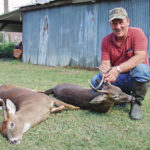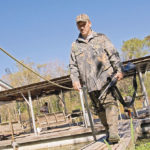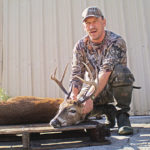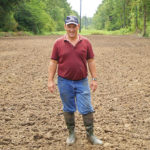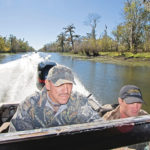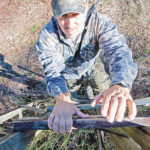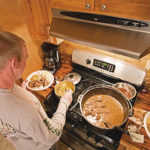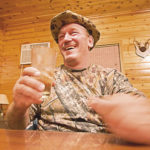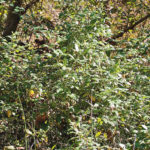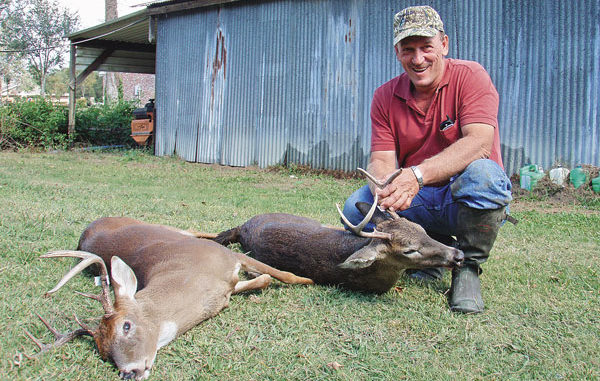
This suddenly famous lifetime swamper has the horns on the wall to prove he knows how to harvest big bucks in wet areas.
Over a year ago, a Pierre Part resident got a call that forever changed his life. A buddy who works at the Louisiana Department of Wildlife and Fisheries called to tell the man that he had just given his name and phone number to some folks from New York.
The yankees were from the History Channel, and they were in Baton Rouge researching a documentary about alligators and people who hunt them. Before they left, they inquired about anybody who might be willing to take them out in a boat. The name and number they left with was Troy Landry’s.
“I started talking to them, and I realized they wanted to film the whole (alligator) season from the first day to the last,” Landry said. “I told them I volunteered but only for one or two afternoons — told them my boat is a work boat and I don’t think I have room for y’all and don’t think I can put up with y’all for the whole season in my boat.”
But after talking it over with his wife, Landry figured he was going to fill his 300 alligator tags whether the film crew was in his boat or not, so he went all in and allowed the crew to ride along and film his entire alligator season.
Swamp People has since skyrocketed to the most popular show on the History Channel, and Landry along with his sons Clint and Jacob have fans from as far away as Australia. Even soldiers stationed in Afghanistan have reported being enamored watching the Landry clan fish for alligators.
Whether you’re listening to kids around the dinner table, students walking through the halls or partiers tailgating before a home LSU football game, the rallying cry for Landry fans is the simple, two-word command he gives to his sons when they have an alligator on the line.
“Choot ‘em!”
The second season of Swamp People will start airing this spring, and Landry says he’s been told that season two is far better than season one. Fifteen or 16 shows are supposed to air instead of the 10 that aired last year.
Although Landry is glad he took those folks from New York alligator hunting, he has discovered that the demands of the show combined with the demands of his crawfish operation have taken time from what he considers his first love — deer hunting.
For 18 years, he was a member of a hunting club in Mississippi, and is a past member of a club in St. Francisville. And he’s hunted Texas, Illinois, Iowa and Nebraska.
However, he never made a hunt at his Mississippi club, and he made only one hunt in St. Francisville after shelling out $600 to join the club. When hunting Texas, Illinois, Iowa or Nebraska, Landry can hardly keep his mind on the giant deer in front of him because it wanders to where he belongs, the Atchafalaya Basin.
“I grew up hunting out here in the Basin, Pierre Part and Belle River,” Landry said while stirring a roux that was the foundation for the night’s dinner of turtle sauce piquant. “All those other places I’ve been to hunt, they got more game, but it’s not home.”
Landry’s camp is located right in the middle of the bottom quarter of the Atchafalaya Basin. His 3,000-acre lease is about a 20-minute boat ride from Belle River Landing, but as homey as his camp might be, Landry knows hunting the Basin is an uphill battle.
“We’re on the bottom end over here, and it’s really low,” Landry explained. “The flood stage in Morgan City is only 4 foot at the Atchafalaya River, where if you go to Butte La Rose, it’s 25 feet.”
Simply put, this means that Landry’s lease is underwater quite a few months of the year. Because of the water rising and falling, the deer in this portion of the Basin tend to migrate a lot.
During low-water years, all the swamp dries up, and all kinds of new, fresh, green things come up, which pulls the deer from far to get in the bottoms. But as soon as the river starts coming up a little bit, it runs them all back to high ground.
“The Attakapas is right next to us,” Landry continued while watching his roux turn to the color of peanut butter. “That’s where a lot of our deer go when the water comes up. The Attakapas got a lot of high ground along the channel.”
Since he has spent a lifetime hunting a swamp, Landry has learned what it takes to consistently kill deer that call the wet stuff home. Whether it’s bedding areas, food plots or what not to hunt, Landry shared some solid advice that can help you kill more deer no matter what low-lying bottoms you hunt.
Bedding areas
“We got mostly swamp and a few little ridges here in the Basin,” Landry said. “Lot of people think the swamp is hard to hunt, but it’s really not that hard because deer bed down in a swamp like this. They get a lot of pressure; they go deep in the swamp — the big bucks. But they getting up around 4:00 or 4:30. I don’t care where you hunt.
“In the swamp, deer will be down on a hill of roots like where a tree fell over in a hurricane or storm. They get on the hill of roots sticking out the water. I’ve even jumped them on big cypress logs. Anything that can keep them dry in the swamp where hunters don’t go is where they bed in the swamp.”
Landry enhances what little dry land he has by heading out after hunting season with a power saw in hand to cut some trees here and there to make briar patches. He has some patches that he says are higher than his camp, and that deer love bedding in this thick, green cover.
“Bucks go deep in the swamp,” he said, “but the does stick around the briar patches, and that’s your ticket to the bucks. But last year during that cold weather we had around the holidays, I went out about 3:00 to hunt some briars. About 4:00, I saw a buck stand up in the briars I was hunting. He was bedded down in there.”
Food plots
Even though he knows he may be planting them for nothing if the water comes up, Landry and his sons love planting food plots on the higher spots within their lease. Although he has some stands overlooking some plots, Landry is more inclined to hunt the trails between the bedding areas and food plots.
“The good thing about a plot out here in the swamp is that long after hunting season is over, the plot is still there until February or March,” Landry said. “They continue to benefit the deer as long as they don’t go underwater.”
Landry typically plants clover because of its ability to grow well in low spots, but he’s recently experimented with American jointvetch and cow peas.
According to the LSU AgCenter’s Food Plot Plantings guide, American jointvetch is a reseeding legume that will grow on sites too wet to support most other food-plot items. Jointvetch also does well in acidic soils with a pH from 5.5 to 6.5, and it produces quality grazing from June through November.
This season presented some new challenges for Landry’s food-plot planting, and the seed he bought for his plots is still sitting at his house. He’s been so busy with Swamp People and building a new house that he didn’t have time to plant.
“If it’s the same with you, get out there and throw out some rye grass so you’ll have something on the ground,” Landry insisted. “That’s what we did this year. We didn’t have time to chop the ground and plant, so we threw out rye grass.”
Don’t hunt the sign
Landry believes a lot of hunters in the Basin hunt the sign rather than the deer. While hunting sign might sound like a tried-and-true tactic, the problem with hunting sign is that there is no way a hunter can tell when deer are actually making that sign.
“Deer might be bedding down a half mile or three quarters a mile from the sign,” Landry said. “These deer are pressured so hard that it’s not like hunting on a big private place where deer bed down 100 yards inside the woods right off a field.
“In here, you might find a plot tore up, but they might not be getting there until 8:00 at night, and you’ll never see him if you’re hunting the sign and not the deer.”
To make sure he’s hunting the deer and not the sign, Landry walks a new hunting area during the middle of the day when deer are bedded down. He tries to jump them so he can figure out where they’re bedding. After jumping a deer, he tries to figure out where that deer is feeding.
“Once I find his bed and where he’s feeding, I hunt close but not too close. You’re going to run them out their bed if you get too close and ruin the hunt. They’ll get up before dark.
“Now they might not move from where they gut up until dark, but they’ll get up. I want to be close enough I can hear them get up without being able to see them. It’s a fine line.”
But it’s a line that Landry has approached without crossing hundreds of times in his life as evidenced in the beams of the shed that covers the old cypress boards that he is ripping and sawing to use in his new house in Pierre Part.
One rack after another hangs over two or three beams for 15 to 20 feet on each beam — each one a reminder of why Landry prefers hunting his home rather than some far-away monster buck mecca. The thing that stands out the most about these racks is that they are nearly all 8 points or better.
“For every deer me and my boys kill, we let four or five little bucks walk,” Landry said as he wrapped up packages of alligator tail meat for his guests to take home. “We don’t always kill monsters because we don’t have a lot of monsters, but we kill a decent little 8-point every now and then.”
This part of Landry’s life might not appeal to the New Yorkers from the History Channel like his 30-day alligator season does, but deer hunting is his first love — a love that has lasted a lifetime.
